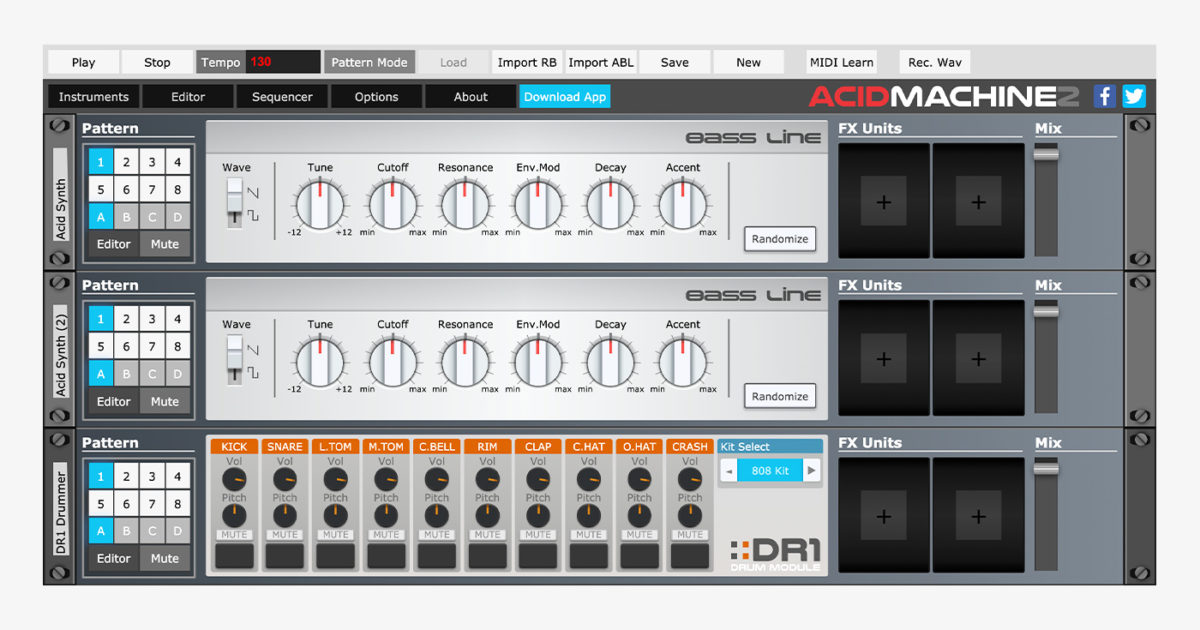
Creative ideas aren’t always easy to come by, so when inspiration hits, it pays to act fast. For many of us, however, those fleeting moments of ingenuity tend to happen far outside the studio – when we’re sitting on a train; stuck at work; or perhaps just curled on the sofa, unwilling to get up and enter a world of cables, gain-staging, and untimely software updates.
That’s why capturing – or even generating – inspiration sometimes demands an entirely different kind of studio: The one you’re reading on this very moment. So, without further delay, here are some of our favourite ways to think outside the box without leaving your browser. All of them are free, many will work on your phone or tablet, and one of them will even let you bring your bandmates.
Blokdust

With slick, minimal graphics and a super-intuitive design, Blokdust feels more like a game than a production tool. Combine that with their quality tutorial and you’ll be experimenting and making complex musical systems in no time. Blokdust allows you to link blocks together and essentially build a synthesizer from scratch, linking various effects just by dragging and dropping. Be sure to check out their example saves to see what’s possible. This one is full of happy accidents.
Acidmachine 2

Here’s a fantastic emulation of not one, but two TB-303s – so you can sequence a melody and a bassline together. Compared to the original hardware, the piano-roll ought to feel like home for those familiar with DAW sequencing. It also comes complete with FX and a built-in drum machine – perfect for demoing how your gnarly bassline will sound over some banging drums before you export and edit it further. With all that functionality, alongside MIDI import and pattern saving, it’s not a stretch to imagine building a whole track right here.
Io808

Another classic coming your way: Vincent Riemer has created a great web version of everyone’s favourite drum machine, the 808. With a killer tutorial in tow, Io808 doubles up as an easy way for anyone to pick up the basics of hardware sequencing – which can be a great way to come up with interesting rhythms that might not occur to you when playing pads or dragging MIDI around in your DAW. And this isn’t a simple sample player – Io808’s sounds are synthesised right here in your browser.
Pixelsynth

Pixelsynth is a clever app that takes an easy-to-grasp concept – it turns pictures into sound – and spits out some seriously wild results. Whether you draw in your own creations or feed it your holiday snaps, the possibilities seem endless. Flicking through the supplied presets should give you a sense of how everything works, and the scale/octave settings provide a means to partially reign in the chaos. We love using this to build pads or atmospheres that might work as a starting point for a new track.
Typatone

Typatone, as its name suggests, turns text into tunes – and it’ll do it as you type, if you prefer. More specifically, it assigns the most common letters of the alphabet to notes on a scale, turning most any string of letters into something musically pleasing and actually rather soothing. It’s pretty nice to just leave this playing itself in the background while you work, or to use it for sending fun messages to friends. It goes to show that inspiration really can come from anywhere: Just plug in some text, scroll through the various modes, and let your imagination roam free.
Ocean Waves

Ocean Waves was created to help lift some of the barriers to entry that are often associated with electronic music-making. And its show-stopping feature is the way it makes it easy to collaborate with friends all over the world in real time. If the rest of the site’s functionality feels a bit limited at the moment, rest assured that more features will be added over time. We particularly like the way the interface makes everything feel simple and easy to use, so it’s a great way to get all your friends as hooked on producing as you are.
Chrome Music Lab

Chrome Music Lab is a suite of different educational tools that allows you to get to grips with musical concepts in a fun and intuitive way. As you’d expect from Google, all the apps are super slick and plenty of fun to look at. You can jot down melodic ideas and rhythms, play with arpeggios, or load up the spectrogram and see what makes a flute sound different from a snare drum or a dial-up modem. The tools may seem simple, but there’s a lot to play with here and, if nothing else, it’s a great way to remind yourself of the fundamentals.















